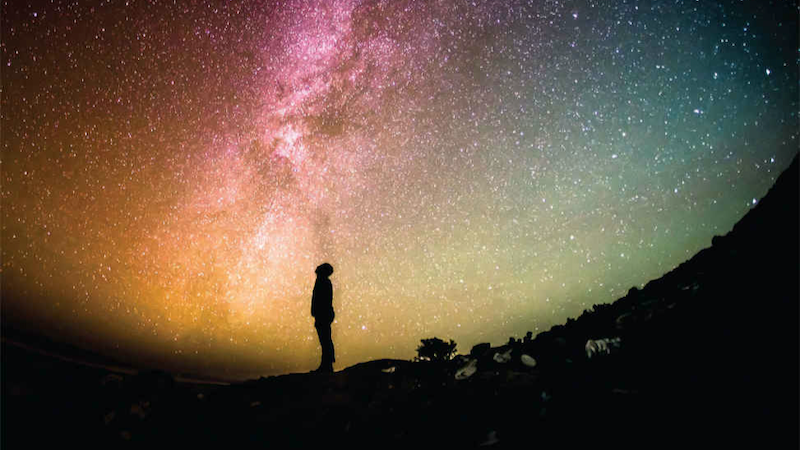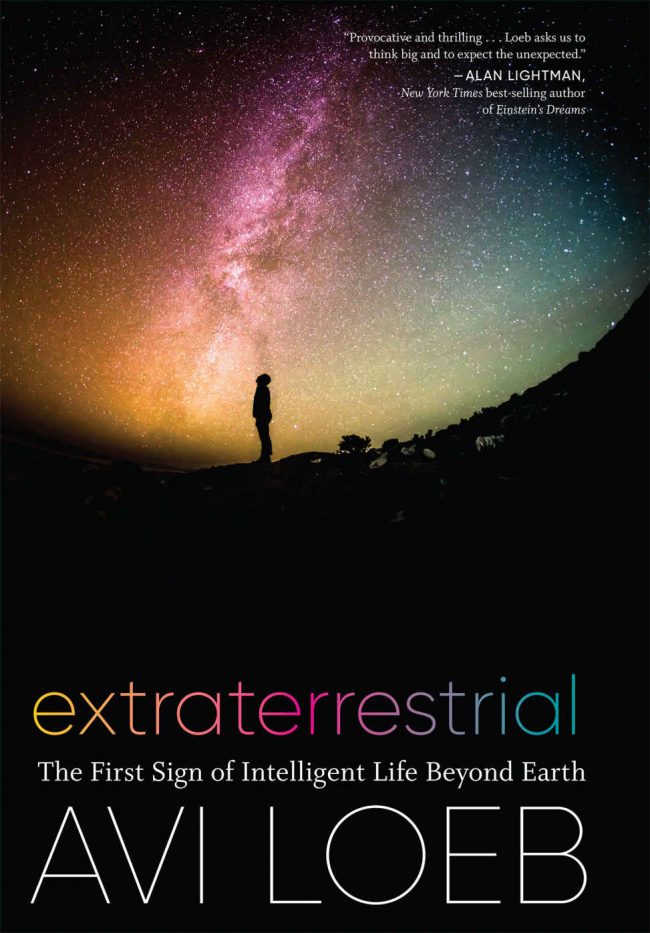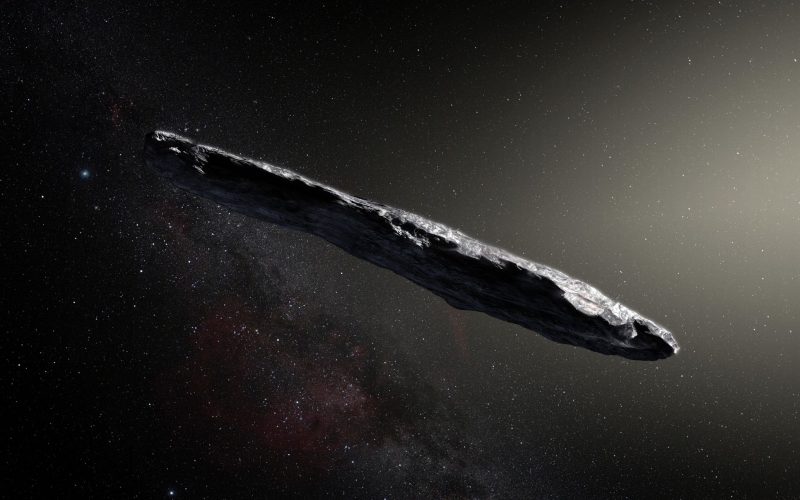Frontlist | The 1st sign of intelligent life beyond Earth?
Frontlist | The 1st sign of intelligent life beyond Earth?on Feb 10, 2021

The 2021 In the Margin Book Award winners and Top 10 lists have been announced.
On October 19, 2017, astronomers using the Pan-STARRS 1 telescope in Hawaii picked up a faint point of light moving across the sky. Some thought it was a comet. Others thought it looked like a typical fast-moving small asteroid. As they tracked its motion, though, astronomers began to be able to calculate the object’s orbit. They soon realized it couldn’t have been an ordinary asteroid or comet; all the asteroids and all (but one) of the comets we know originate inside our solar system. This thing wasn’t a solar system object. It was, without a doubt, from interstellar space. Since then, most astronomers have come to believe that 1I/’Oumuamua, as it’s now known, is a natural object. But Harvard physicist Avi Loeb still thinks it might be the first known example of an alien artifact, something manufactured by extraterrestrial beings, come to us from another star system. Loeb’s new book – called Extraterrestrial, the First Sign of Intelligent Life Beyond Earth – explores this possibility.
At this writing, Loeb’s book is already #6 on the New York Times bestseller list. I haven’t read it yet, but science writer Dennis Overbye of the New York Times calls it:
 So it’s no surprise that Loeb (in his spare time) has written a book exploring the possibility that ‘Oumuamua might be artificial. He wasn’t the only scientist to suggest artificial origins for ‘Oumuamua when it first appeared on the scene. In 2018, scientists at the SETI Institute used the Allen Telescope Array to observe ‘Oumuamua as it was retreating from our sun’s vicinity, when it was about 170 million miles (274 million km) away, or slightly less than the diameter of Earth’s orbit around the sun. Their intention was to search for artificial radio transmissions from ‘Oumuamua, which, if found, would be strong evidence that this object is no simple rock tossed into space by a random gravity assist that took place long ago in a star system far, far away. But no artificial signals were ever found. That lack of evidence, and other evidence based on observations of ‘Oumuamua as it raced away from our sun, caused most scientists to conclude that this dark red object – estimated to be between 300 and 3,000 feet long (100 and 1,000 meters long) – was a natural object.
Are we alone? Over time, this question has been framed in different ways. Is life here on Earth the only life in the universe? Are humans the only sentient intelligence in the vastness of space and time? A better, more precise framing of the question would be this: Throughout the expanse of space and over the lifetime of the universe, are there now or have there ever been other sentient civilizations that, like ours, explored the stars and left evidence of their efforts?
I believe that, in 2017, evidence passed through our solar system that supports the hypothesis that the answer to the last question is yes. In this book, I look at that evidence, test that hypothesis, and ask what consequences might follow if scientists gave it the same credence that they do to conjectures about supersymmetry, extra dimensions, the nature of dark matter, and the possibility of a multiverse.
In 1973, by coincidence, the British writer Arthur C. Clarke released a science fiction novel called “Rendezvous with Rama” which echos some parts of ‘Oumuamua’s true story. It’s a marvelous book, which won won both the Hugo and Nebula awards (science fiction’s highest awards) upon its release.
So it’s no surprise that Loeb (in his spare time) has written a book exploring the possibility that ‘Oumuamua might be artificial. He wasn’t the only scientist to suggest artificial origins for ‘Oumuamua when it first appeared on the scene. In 2018, scientists at the SETI Institute used the Allen Telescope Array to observe ‘Oumuamua as it was retreating from our sun’s vicinity, when it was about 170 million miles (274 million km) away, or slightly less than the diameter of Earth’s orbit around the sun. Their intention was to search for artificial radio transmissions from ‘Oumuamua, which, if found, would be strong evidence that this object is no simple rock tossed into space by a random gravity assist that took place long ago in a star system far, far away. But no artificial signals were ever found. That lack of evidence, and other evidence based on observations of ‘Oumuamua as it raced away from our sun, caused most scientists to conclude that this dark red object – estimated to be between 300 and 3,000 feet long (100 and 1,000 meters long) – was a natural object.
Are we alone? Over time, this question has been framed in different ways. Is life here on Earth the only life in the universe? Are humans the only sentient intelligence in the vastness of space and time? A better, more precise framing of the question would be this: Throughout the expanse of space and over the lifetime of the universe, are there now or have there ever been other sentient civilizations that, like ours, explored the stars and left evidence of their efforts?
I believe that, in 2017, evidence passed through our solar system that supports the hypothesis that the answer to the last question is yes. In this book, I look at that evidence, test that hypothesis, and ask what consequences might follow if scientists gave it the same credence that they do to conjectures about supersymmetry, extra dimensions, the nature of dark matter, and the possibility of a multiverse.
In 1973, by coincidence, the British writer Arthur C. Clarke released a science fiction novel called “Rendezvous with Rama” which echos some parts of ‘Oumuamua’s true story. It’s a marvelous book, which won won both the Hugo and Nebula awards (science fiction’s highest awards) upon its release.
… part graceful memoir and part plea for keeping an open mind about the possibilities of what is out there in the universe – in particular, life.Keeping an open mind seems to be one of the things Avi Loeb does best. He’s a particularly creative thinker among scientists (who are no slouches at creative thinking, generally). For example, Loeb proposed in 2012 that the bright lights of cities, which are visible on a planet even from space, might reveal the existence of alien life on exoplanets. In 2014, he was a co-author of a study suggesting we might find alien life by looking for industrial pollution in exoplanet atmospheres. In 2016, he participated in the announcement of Breakthrough Starshot, still engaged in proof-of-concept for light-propelled Minecraft that might reach the nearest star system in 20 years. And, in 2019, Loeb was part of a study questioning what happened before the Big Bang. EarthSky lunar calendars are back in stock! We’re guaranteed to sell out – get one while you can!
 So it’s no surprise that Loeb (in his spare time) has written a book exploring the possibility that ‘Oumuamua might be artificial. He wasn’t the only scientist to suggest artificial origins for ‘Oumuamua when it first appeared on the scene. In 2018, scientists at the SETI Institute used the Allen Telescope Array to observe ‘Oumuamua as it was retreating from our sun’s vicinity, when it was about 170 million miles (274 million km) away, or slightly less than the diameter of Earth’s orbit around the sun. Their intention was to search for artificial radio transmissions from ‘Oumuamua, which, if found, would be strong evidence that this object is no simple rock tossed into space by a random gravity assist that took place long ago in a star system far, far away. But no artificial signals were ever found. That lack of evidence, and other evidence based on observations of ‘Oumuamua as it raced away from our sun, caused most scientists to conclude that this dark red object – estimated to be between 300 and 3,000 feet long (100 and 1,000 meters long) – was a natural object.
Are we alone? Over time, this question has been framed in different ways. Is life here on Earth the only life in the universe? Are humans the only sentient intelligence in the vastness of space and time? A better, more precise framing of the question would be this: Throughout the expanse of space and over the lifetime of the universe, are there now or have there ever been other sentient civilizations that, like ours, explored the stars and left evidence of their efforts?
I believe that, in 2017, evidence passed through our solar system that supports the hypothesis that the answer to the last question is yes. In this book, I look at that evidence, test that hypothesis, and ask what consequences might follow if scientists gave it the same credence that they do to conjectures about supersymmetry, extra dimensions, the nature of dark matter, and the possibility of a multiverse.
In 1973, by coincidence, the British writer Arthur C. Clarke released a science fiction novel called “Rendezvous with Rama” which echos some parts of ‘Oumuamua’s true story. It’s a marvelous book, which won won both the Hugo and Nebula awards (science fiction’s highest awards) upon its release.
So it’s no surprise that Loeb (in his spare time) has written a book exploring the possibility that ‘Oumuamua might be artificial. He wasn’t the only scientist to suggest artificial origins for ‘Oumuamua when it first appeared on the scene. In 2018, scientists at the SETI Institute used the Allen Telescope Array to observe ‘Oumuamua as it was retreating from our sun’s vicinity, when it was about 170 million miles (274 million km) away, or slightly less than the diameter of Earth’s orbit around the sun. Their intention was to search for artificial radio transmissions from ‘Oumuamua, which, if found, would be strong evidence that this object is no simple rock tossed into space by a random gravity assist that took place long ago in a star system far, far away. But no artificial signals were ever found. That lack of evidence, and other evidence based on observations of ‘Oumuamua as it raced away from our sun, caused most scientists to conclude that this dark red object – estimated to be between 300 and 3,000 feet long (100 and 1,000 meters long) – was a natural object.
Are we alone? Over time, this question has been framed in different ways. Is life here on Earth the only life in the universe? Are humans the only sentient intelligence in the vastness of space and time? A better, more precise framing of the question would be this: Throughout the expanse of space and over the lifetime of the universe, are there now or have there ever been other sentient civilizations that, like ours, explored the stars and left evidence of their efforts?
I believe that, in 2017, evidence passed through our solar system that supports the hypothesis that the answer to the last question is yes. In this book, I look at that evidence, test that hypothesis, and ask what consequences might follow if scientists gave it the same credence that they do to conjectures about supersymmetry, extra dimensions, the nature of dark matter, and the possibility of a multiverse.
In 1973, by coincidence, the British writer Arthur C. Clarke released a science fiction novel called “Rendezvous with Rama” which echos some parts of ‘Oumuamua’s true story. It’s a marvelous book, which won won both the Hugo and Nebula awards (science fiction’s highest awards) upon its release.
Set in the 2130s, the story involves a huge object discovered moving inward through our solar system while still outside the orbit of Jupiter (‘Oumuamua had already come closest to the sun, and was on its way out of the solar system, when it was discovered in 2017). Clarke’s fictional object was also thought to be a natural object at first and was given an asteroid designation of “31/439.” But – just as with ‘Oumuamua – astronomers’ tracking of the object’s movement through space revealed its interstellar origins.
The object in Clarke’s book was named Rama after Ramachandra, a major deity of Hinduism. An uncrewed space probe – launched from the Mars moon Phobos – was sent to intercept it and photograph it, and the photos revealed an object 12 miles (20 km) wide and 31 miles (50 km) long: a perfect cylinder. The rest of the book is taken up with the rush to explore Rama for the short time it will pass through our solar system. An earthly astronaut does manage to enter it (through triple airlocks), but Rama’s nature and purpose – and any idea of who created it – remains unknown.
Unlike Clarke’s fictional story, in part because the human race doesn’t yet have launch facilities on Phobos, the real story of ‘Oumuamua doesn’t include a close-up photo of the object. All the images you ever see of it are artist’s conceptions. They all show a rocky, asteroid-like object. Shortly after astronomers first spotted it in 2017, ‘Oumuamua was given the label A/2017 U1 (with the A for asteroid). That’s in part because ‘Oumuamua never showed any comet-like activity (unlike the second interstellar object, now called 2I/Borisov, which was identified as a comet).
Of course, the real ‘Oumuamua is much smaller than Clarke’s fictional object Rama. At most, ‘Oumuamua is only 3,000 feet (1,000 meters) long, in contrast to Rama’s 31 miles (50 km).
But many parts of Clarke’s fictional story do imitate real life, as it unfolded decades after Clarke’s book was published. For example, it was only as its interstellar orbit came to be recognized and understood that the 2017 object became the first body ever to receive an I (for interstellar) designation from the International Astronomical Union, which created a new category after its discovery. Now the object’s full official name is 1I/2017 U1 (‘Oumuamua). It can also be correctly referred to as 1I, 1I/2017 U1, and 1I/’Oumuamua.
The name ‘Oumuamua, which reflects the object’s discovery by astronomers in Hawaii, means scout or messenger. We most often see that name explained as:
 Bottom line: Physicist Avi Loeb of Harvard has a new book called “Extraterrestrial, the First Sign of Intelligent Life Beyond Earth,” about the anomalous space object ‘Oumuamua.
Bottom line: Physicist Avi Loeb of Harvard has a new book called “Extraterrestrial, the First Sign of Intelligent Life Beyond Earth,” about the anomalous space object ‘Oumuamua.
Source: Earth Sky… sent from the distant past to reach out to us.And that of course is true, since distances in space are so vast. In space, stretches of distance and stretches of time are linked. But, in fact, ‘ou means reach out for, and mua means first, in advance of: scout. And that brings us full circle, to Avi Loeb’s new book and conjecture about this object. What if ‘Oumuamua really were a kind of scout from sentient beings? Considering that possibility is the kind of open-minded thinking that I suspect Avi Loeb would approve.

Artist’s concept of ‘Oumuamua, whose actual appearance is unknown.
Author
Authors
Bestseller
Book
Frontlist Latest news
Google news
Indian authors
Latest news
Margin Book Award



.jpg)






.jpg)

.jpg)
.jpg)
.jpg)
.jpg)
.jpg)
.jpg)

.jpg)










Sorry! No comment found for this post.